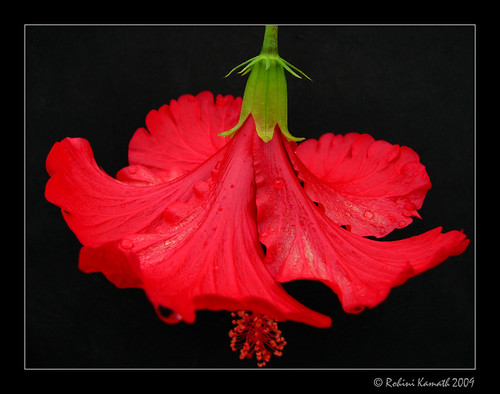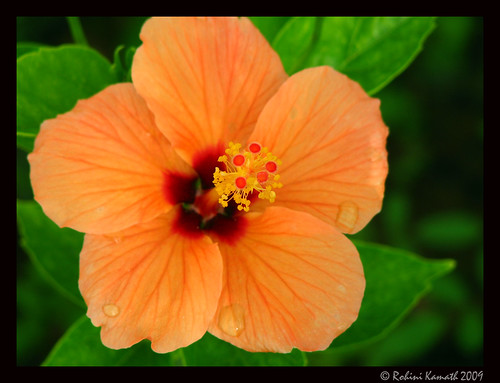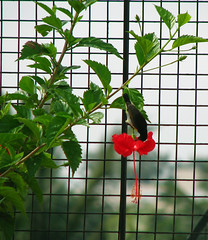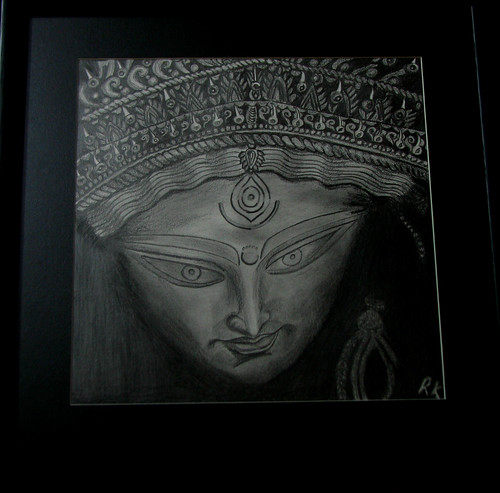
Red Hibiscus after the Rains
The Hibiscus is a large genus which includes about 200–220 species of flowering plants in the family Malvaceae native to warm, temperate, subtropical and tropical regions throughout the world. It includes both annual and perennial herbaceous plants, as well as woody shrubs and small trees.
Origin of Names:
It is also called the Shoe Flower and China Rose.
ShoeFlower:
Perhaps the name "shoe flower" orginated in Jamaica - the petals of hibiscus makes a good shoe shine!
China Rose:
The latin name translates as China Rose, though it is not known if its origins lie in China
I have 2 varieties in my garden:
The Red Hibiscus (Hibiscus rosa-sinensis)
and A Orange-Pink Hybrid. ( I don't know the name of this one )
Originating in Asia and the Pacific islands, Hibiscus rosa-sinensis is the national flower of Malaysia. Ive seen Native species in Bangalore in Pink, White and Yellow. (I'm looking to acquire a pink one). There are also double varieties, which has a smaller flower inside a bigger one.

Orange Pink Hybrid
For the Birds
The Hibiscus is a sunbird magnet; I have also seen a few Great Tits checking it out. The Sunbirds help pollinate the hibiscus and many use Hibiscus plants as nesting sites.
While I haven't yet had the honour of being landlord to a sunbird, I have tried to encourage them by placing a shallow wide mouthed earthen vessel filled with water at the bottom of my Hibiscus bush.

Purple Rumped Sunbird Male at Breakfast
Sorry, This is a bad photo. He surprised me while I was taking a photo of another flower, so I didnt have much time.
After experimenting with several areas of the garden, this seems to be the best spot. It gives the birds some cover while they drink and bathe. I've also put a large pebble in it as a base for some of the tinier customers to stand on.
Native vs. Hybrid
I personally prefer the naturally occurring variety.
In general, the Hybrid Fancy looking ones tend to be more expensive to buy.
The naturally occurring variety grow rapidly, need little care, flower daily ( at least 1 and at max 5 ).
They are not affected by pests, which is big problem with the hybrid one ( its a bit of a delicate darling ).
Also, my sunbirds only like the Native Red one, and visit it daily; several times a day. Not once do they go near the hybrid.
Native Red (6 ft in 1.5 yrs), 1-5 flowers at a time, flowers daily
Orange Hybrid ( 2ft in 1 yr ), 1-3 flowers, flowers once a month
Propagation and Growth:
Propagation By Rooting Cuttings ( I haven't tried this myself )
Regular pruning encourages branching, and I found that this is very much needed, since they tend to growth rapidly and soon tower over you. The hybrid one is prone to aphids but it does recover once treated with insecticide. I also found that the hybrid one occasionally suffers from a problem of falling buds.
I find that they like lot of water and are very tolerant to sun (esp. the native one ). I haven't seen any seeds or Fruit. The flowers bloom just after sun rise and close up by late evening.

A Quick Lesson in Botany
A flower's male stamens are composed of the pollen-producing anther atop a stemlike filament, those roundish, yellow things in the picture are anthers that have opened and are discharging yellow pollen. The thick column they are attached to is called the staminal column.
The style is the big stem in the center that separates into five style-branches, and each style branch ends in a roundish stigma (red fuzzy things).
Source: http://www.backyardnature.net/fl_hibsc.htm
Uses:
In India, people use the hibiscus for hair care purposes. The leaves and flowers are soaked in water and ground to make a thick paste. This is applied to the scalp and later washed off. This serves (reportedly) to arrest hair-fall, treat dandruff and also for colouring. It is also commonly offered in prayers to dieties.
Trivia:
Dried hibiscus is edible, and is a delicacy in Mexico.
The red hibiscus flower is traditionally worn by Tahitian women. A single flower is tucked behind the ear. Which ear is used indicates the wearer's availability for marriage.
Sources:
Flowers Of India
Wikipedia






